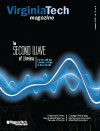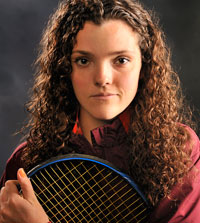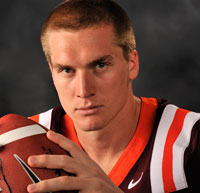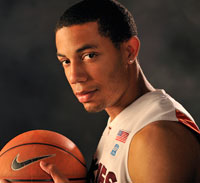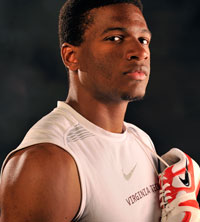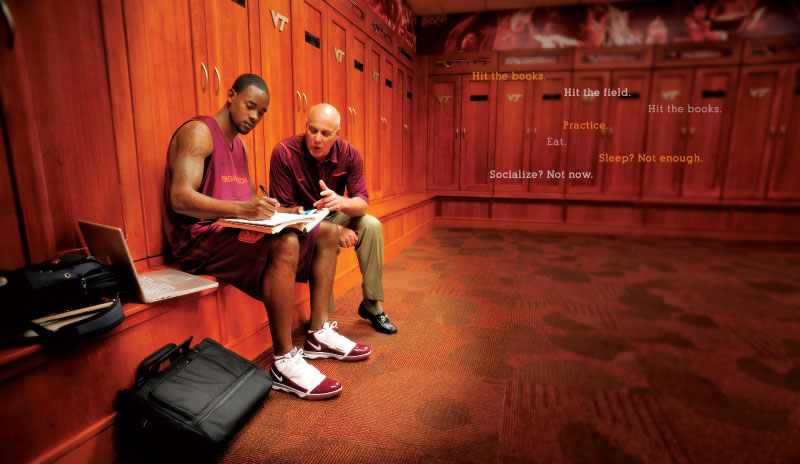 |
|
||||||
|
|
|||||||||||||||||||||||||||||||||||||||||||||||||||||||||||||||||||||||||||||||||||||||||||||||||||||||||||||
|
Diploma-Driven
by RICHARD LOVEGROVE
Blakely, a rising senior who plays on the Virginia Tech women's tennis team, carries a 3.97 grade point average while majoring in chemistry and biochemistry with a minor in mathematics. She earned the 2010 Skelton Award for Academic Excellence in Athletics as the top female scholar-athlete at Tech and is an all-ACC academic tennis team honoree and a Goldwater Scholar, among other accolades. This fall, she plans to apply for a Rhodes Scholarship. In fall 2010, however, Blakely faced the possibility that she would be declared ineligible to play tennis in spring 2011. Because she was concentrating on biochemistry and mathematics, she wouldn't meet the NCAA requirement that she take six credits in her primary major, chemistry. "That was when our support system was put to the test," Blakely said. Virginia Tech Student-Athlete Academic Support Services (SAASS), working with the chemistry department, stepped in and convinced the NCAA that Blakely deserved a waiver. As a result, she stayed on track—academically and athletically. "I have great support," Blakely said. "The chemistry department has been huge, and the athletic department has been huge." Whether they're studying game film or for an exam, juggling a quick strike from a quarterback or a complicated semester schedule, student-athletes lead hectic lives. Support is essential, no matter the student's sport or academic acumen, according to Jermaine Holmes (business marketing '96, M.A. resource management '98), SAASS director and a former Hokie football player. Student-athletes face initial and continuing eligibility requirements that are more intricate than those for non-athletes—as Blakely discovered—and they frequently live in a fishbowl, showcasing Virginia Tech for the public and managing the academic and social demands of college. The balancing act can be challenging. "A lot of people just see the Saturday football game or the Wednesday basketball game, so they don't understand all the time and effort that goes into being a student-athlete," Holmes said. "It's basically like having two full-time jobs." Virginia Tech senior wide receiver Danny Coale knows the feeling. Normally, he's up by 6:30 a.m. In a typical long day, he'll go to class, watch game film, eat meals to keep fueled, lift weights, sit through taping sessions in the training room, attend position meetings, and, of course, sweat through practice. He'll also hit the books during spare moments, as well as devote 10-15 hours per week to investment research as a member of Student Endowment for Educational Development, a student-run group that manages a multimillion-dollar portfolio for the university's endowment. At the end of what most would consider a grueling day, Coale returns to his apartment by about 9 p.m.—only to face more schoolwork. "It's the last thing you really want to do," Coale said of late-night homework. "You just want to sit on the couch and watch TV and relax. But when you come in as a freshman … they teach you to manage your time." Coale has managed his time well enough that he earned a degree in finance in December 2010. He red-shirted his freshman year, so he's staying for a fifth year to complete a degree in marketing—and a fourth year as a starting wide receiver. SAASS is the primary university entity that helps Coale, Blakely, and 520 other Virginia Tech student-athletes learn how to budget their academic, athletic, and social time and keep up with the NCAA's intricate rules. As a collaboration between the athletics department and the provost's office, SAASS is funded by both the university and the athletics department. Years ago, according to Karen Eley Sanders, the university's associate vice president for academic support services, the athletics department handled all interactions with athletes, "but we moved to a different model, and we think it's an appropriate model. Our system is working. Our student-athletes are performing [academically]. They are students first. They came to Virginia Tech to advance their education." When Holmes attended Tech in the 1990s, academic support for athletes consisted of two employees and a handful of tutors jammed into some small rooms in Cassell Coliseum. Now, 11 employees and 80 to 100 tutors in an 18,000-square-foot facility on the west side of Lane Stadium offer 8,000 annual hours of tutoring, daily study halls, mentoring to teach student-athletes how to balance demands, and a gleaming computer lab. The improvements were fueled partly by the growth in athletics, partly by a desire to see students-athletes improve academically, and partly by recent and stricter NCAA regulations that track the progress of individual athletes and whole teams toward degrees. "[The improvements] definitely have been a change, and I think it's helped our student-athlete population tremendously," Holmes said. While the facility for student-athletes is unquestionably convenient and comfortable, the services offered are generally the same as those provided to other populations, such as first-generation college students, Corps of Cadets members, or students who are, for instance, struggling with math, said Sarah Armstrong (human development '03), SAASS associate director and advisor for football. "We offer (student-athletes) a one-stop shop with the NCAA component in there," said former Hokie swimmer Katie Cross (political science, communication '97), SAASS associate director and advisor for men's and women's basketball and volleyball. Cross knows that college athletes constantly battle stereotypes, none more persistent than the myth that all "jocks" are on campus for sports and little else. But she sees all types taking advantage of SAASS. "[The services are] not just for students who need help," Cross said, "[but] for the students who have some big goals they want to accomplish, and for students who want to make sure they get an ‘A' in their class." In fact, according to the NCAA, student-athletes traditionally graduate at rates higher than the overall student body. Tech's rate was 89 percent for the freshman class of 2003-04, well above the national rate of 79 percent for student-athletes. The football team's 79 percent rate was the fifth highest among the top 25 schools in the Bowl Championship Series standings. "Our student-athletes are just as academically talented as the rest of the undergraduate student body," said Sanders. Hasheem Halim, who won the ACC outdoor triple jump title this spring and went on to place fourth at the national championships, knows about the stereotypes. He came to Virginia Tech to study architecture, an exceedingly difficult major to juggle with athletics. He's rarely home except to sleep. His coach allowed him to start practice late to accommodate studio time for architecture and the architecture department also cooperated. "I really had to communicate with my teachers and get a different plan than other students," he said. Still, Halim said, some people connected with athletics were discouraging about the demands of the major, and "sometimes in the architecture department, people don't think I'm really an architecture student. People do ask me if I came here for track. I don't know what they're thinking." Blakely and Halim demonstrate a key point of which Tech's student-athletes are well aware: For most collegiate athletes, a professional athletic career isn't on the horizon. The numbers from the NCAA tell the story. Of approximately 540,200 high school students playing men's basketball, only about 44 of those students eventually will be drafted from college into the pros. About 66,300 of more than 1.1 million high school football players will make it to the NCAA, level, and each year about 250 will move on to the pros. Of six sports highlighted by the NCAA report—men's and women's basketball, football, men's soccer, baseball, and ice hockey—the percentage of high school players who eventually earn a shot at the pros ranges from 0.03 percent to 0.44 percent. "I believe that most athletes understand that they will not move on to the professional ranks, so we spend a good amount of time talking about how to prepare for the real working world—for example, internship experience, networking, résumé preparation and interviewing skills, and how to sell themselves as athletes," Holmes said. Head basketball coach Seth Greenberg is aware of the odds. When he and his assistants are recruiting, there's one question they always ask: How much does the student value earning a college diploma? Because of that emphasis on athletics and academics during Greenberg's eight-year tenure, every player who has remained with the program until his senior year has walked away with a degree. "It's a big part of who we are," Greenberg said, who praises Tech's SAASS and its facilities as among the top in the country. "Not competing in the classroom is not an option. … We want [student-athletes] to leave Virginia Tech with the total experience, and a degree is part of the total experience." And just like other young people off on their own for the first time, student-athletes will sometimes waver, Greenberg said. "It's no different from the kid in a fraternity or a club. ... [We] hold the kids accountable." Star basketball forward Erick Green went to private school for a year to prepare for both college athletics and academics, and although he thought he was ready, he acknowledges that he struggled some his first year. "I felt like, hey, I'm out here, and I'm playing basketball, and I wasn't as serious [as I should have been]," Green said. The support system helped turn his academic outlook around, but Green also had to show the initiative. "They can tell you [what you need to do], but they don't do it for you. You've got to do it yourself. "To be honest, I've grown up," Green added. "I know that one day basketball's going to end." "There is always room for improvement when you talk about performing academically," Holmes said of Tech's academic support efforts. "In a perfect world, we would have 100 percent retention and graduation rates across all of our sports. In the meantime, we will continue to push our student-athletes to perform at the highest level possible."
|
|
||||||||||||||||||||||||||||||||||||||||||||||||||||||||||||||||||||||||||||||||||||||||||||||||||||||||||||
|
|||||||||||||||||||||||||||||||||||||||||||||||||||||||||||||||||||||||||||||||||||||||||||||||||||||||||||||
|
|||||||||||||||||||||||||||||||||||||||||||||||||||||||||||||||||||||||||||||||||||||||||||||||||||||||||||||

